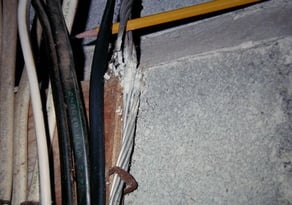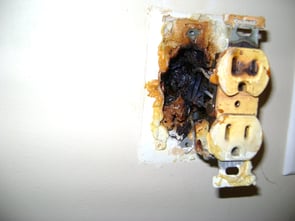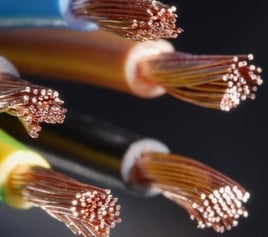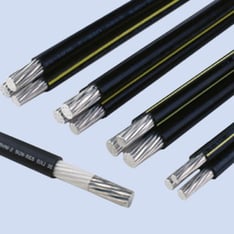 And that’s when I saw it. My first reaction was to run out of the building. Aluminum conductors thicker than my thumb, had lost several feet of their insulation at the connection points and bare aluminum was showing. But not just aluminum, mostly white powder. As if the conductors had started to evaporate into the air. When iron rusts, the oxidized product is red. When copper rusts/oxidizes, it turns green. And when aluminum rusts it turns white. Oxidized copper is still a pretty good conductor, but oxidized aluminum is a very poor conductor. Back in the 1960s and 70s, about 2 million homes in the US were wired with aluminum. It was the peak of the Vietnam war and there was a big shortage of copper in our country. Aluminum was cheaper and lighter in weight, and it had been approved back in 1945 for use in home wiring. So why not! Well, as it turns out there were some very good reasons why not. For starters, electricians didn’t know that they needed to use aluminum rated devices such as switches and receptacle outlets. The devices they used were not compatible with aluminum wire. As a result, the aluminum conductors loosened up under the screws and started fires. All wires, when carrying current, heat up. And when they heat up, they expand. And when they cool, they contract.
And that’s when I saw it. My first reaction was to run out of the building. Aluminum conductors thicker than my thumb, had lost several feet of their insulation at the connection points and bare aluminum was showing. But not just aluminum, mostly white powder. As if the conductors had started to evaporate into the air. When iron rusts, the oxidized product is red. When copper rusts/oxidizes, it turns green. And when aluminum rusts it turns white. Oxidized copper is still a pretty good conductor, but oxidized aluminum is a very poor conductor. Back in the 1960s and 70s, about 2 million homes in the US were wired with aluminum. It was the peak of the Vietnam war and there was a big shortage of copper in our country. Aluminum was cheaper and lighter in weight, and it had been approved back in 1945 for use in home wiring. So why not! Well, as it turns out there were some very good reasons why not. For starters, electricians didn’t know that they needed to use aluminum rated devices such as switches and receptacle outlets. The devices they used were not compatible with aluminum wire. As a result, the aluminum conductors loosened up under the screws and started fires. All wires, when carrying current, heat up. And when they heat up, they expand. And when they cool, they contract.  Aluminum expands and contracts 35% greater than copper. Couple that with connection lugs and screws that are not suitable for terminating aluminum, and you have a very good chance of loosening the connection. A loose connection heats up even more and accelerates oxidation. Overall, this is a bad combination and a sure bet for starting a fire. It soured the construction industry, but it soured the insurance industry even more. To a point that insurers wanted nothing to do with aluminum wired homes. There was nothing wrong with the wire. Just that the devices were not appropriate. But the insurance companies insisted on completely replacing all the wiring, at great expense.
Aluminum expands and contracts 35% greater than copper. Couple that with connection lugs and screws that are not suitable for terminating aluminum, and you have a very good chance of loosening the connection. A loose connection heats up even more and accelerates oxidation. Overall, this is a bad combination and a sure bet for starting a fire. It soured the construction industry, but it soured the insurance industry even more. To a point that insurers wanted nothing to do with aluminum wired homes. There was nothing wrong with the wire. Just that the devices were not appropriate. But the insurance companies insisted on completely replacing all the wiring, at great expense.
So, forget the small gauge wires. Let’s talk about the large stuff. Feeders to panels and to large, non-vibrating equipment are acceptable candidates for aluminum conductors. Copper is still the better conductor. It’s like driving to work in a Cadillac versus in a Chevrolet. They are both going to get you there, but you are more comfortable in the Caddy and you will turn more heads. You need to go to a larger conductor because aluminum has a lesser conductivity. But I must admit that aluminum is a lot lighter than copper. Electricians love working with it. There is no question that you have to exercise care in terminating both copper and aluminum. But the care in aluminum is at a whole different level. Copper is much more forgiving. Aluminum not only has to be terminated with specifically approved devices, it also has no tolerance for sloppiness. It is not as pliable as copper, so pulling with excessive force can damage it. If bent too many times, it will break. And very importantly, if exposed to air, it will oxidize very quickly. And so any bare ends need to be coated with an anti-oxidant. There are two ways to terminate any wire, crimp or mechanical connection. Crimping is done with a hydraulic tool, that essentially embeds the conductor into the termination. Mechanical is simply putting a screw on the wire and cranking it down. They are both approved and with the appropriate devices, they both work well. I’m partial to the crimp type termination, and again it’s just the Caddy/Chevy comparison. I just know that I can cross off a crimped termination as done. Like final. And lastly, aluminum conductors don’t do well submersed in water, as in underground installation. Completely stay away from that scenario.
 VS.
VS. 
In the end, the question of copper vs. aluminum comes up regularly. At KEA, we design all our projects based on copper conductors. We size all the conduits based on the sizes of the copper conductors. If the job is to be built in aluminum, the conductors must be up-sized and most of the time that means larger conduit. The question often comes from the electrician, who is trying to save money, mostly to value engineer the project. There is nothing wrong with this so long as either the engineer or the electrician, if qualified, adjusts the wire and conduit sizes to go from copper to aluminum, and uses proper devices and terminations. In my book, they should be coated in anti-oxidant and using crimp type connections as well. And NEVER underground or for that matter in conduits that can have standing water.Having said all of the above, Aluminum conductors can be used in the hands of a competent electrician who understands all of the issues and follows all of the recommended procedures. KEA is always available for consultation on this and any other engineering matters.
